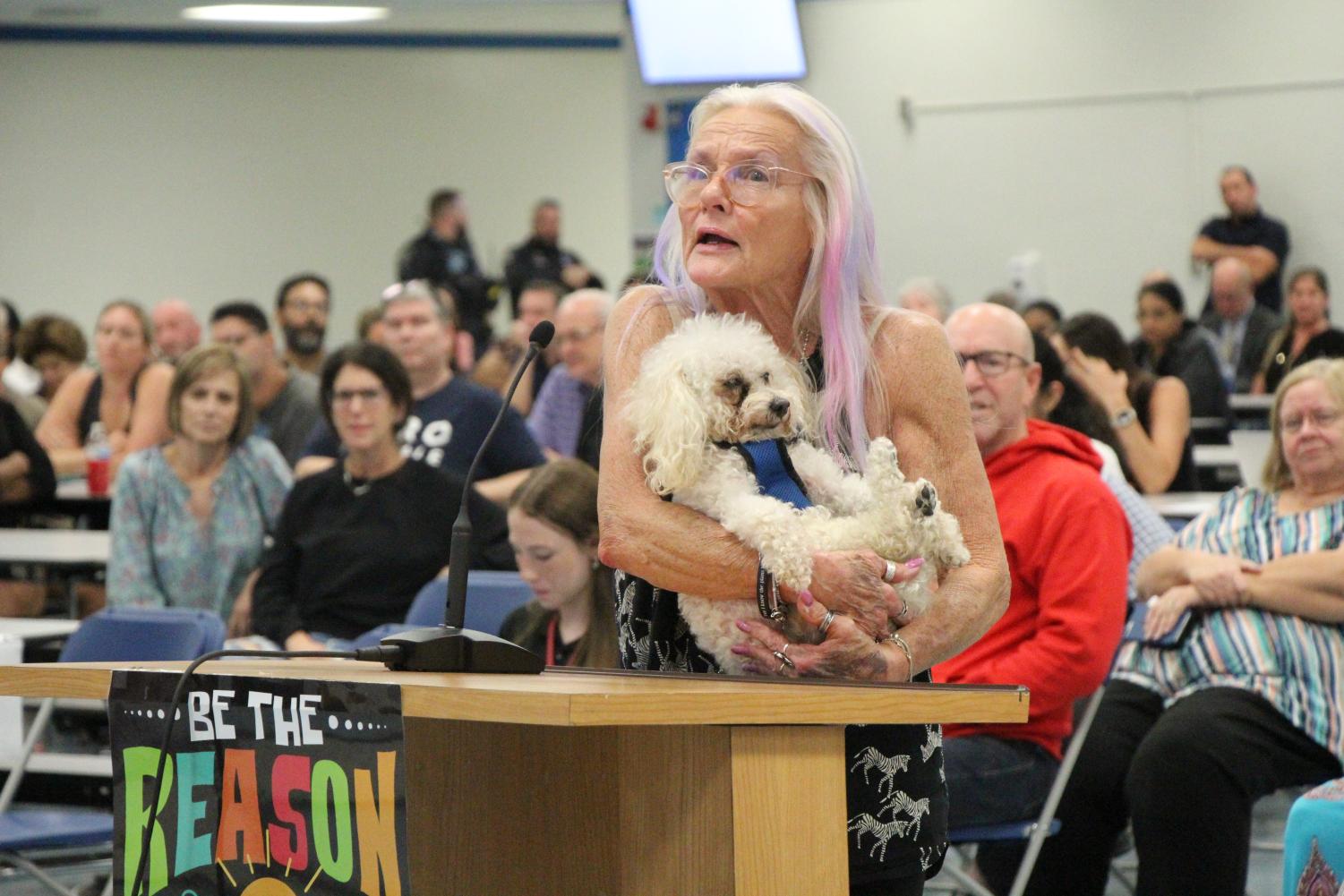Your donation will support the student journalists of Marjory Stoneman Douglas High School. Your contribution will allow us to purchase equipment and cover our annual website hosting costs.
District initiates process to redraw MSD boundary lines to reduce overcrowding
December 14, 2022
“When [the demographers] say the Sawgrass Expressway is not a natural boundary, the kids in my neighborhood do not play with kids in Coral Springs,” a Parkland resident said before being interrupted by a booing crowd and yelling from Coral Springs Vice Mayor Joshua Simmons, who ultimately walked out of the meeting.
Coral Springs and Parkland community members’ remarks at both the Oct. 3 and Nov. 4 meeting sound like something out of a Parks and Recreation episode; however, it is not a sitcom, but rather a very real discussion about changing the Marjory Stoneman Douglas High School boundary. At both meetings, the discussion of which neighborhoods might be zoned out of the school as early as next school year continued through a sea of periodic booing, cheering, clapping and interruptions.
After students returned to campus from COVID-19 virtual learning last year, students and staff felt the school was bursting with students they did not have room for.
As outlined in an investigative news story published last year, Eagle Eye News discovered that the school’s enrollment rose by 281 students since students were last on campus in the 2019-2020 school year; which followed a 7.5% average population increase on campus.
Student reporters also discovered that the school was listed as under capacity on district and state reports when it was actually operating at 116% capacity. The issue went unaddressed due to an inaccurate Florida Inventory of School Houses capacity report.
After the shooting at MSD on Feb. 14, 2018, the 1200 building was designated as a crime scene and permanently closed. It has not been occupied since, which lowered the school’s capacity by 30 classrooms or 713 students. In 2018, the Florida Legislature provided $20 million to Broward County Public Schools for the demolition of the 1200 building and the construction of a replacement building.
The 1500 building opened during the 2020-2021 school year with 30 additional classrooms, which added a capacity of 750 students to the school’s FISH report. The purpose of the addition was to replace the capacity lost from the inaccessibility and eventual demolition of the 1200 building. The intention was not to raise the FISH capacity but to level out the capacity to the number before the incident.
In fact, Eagle Eye News discovered BCPS district officials continued to calculate the space in the 1200 building in the school’s total capacity.
In September, BCPS announced that MSD is in fact over capacity, functioning at 114% capacity due to a slight decrease in student enrollment this year. The announcement also informed the community that BCPS officials in charge of boundary changes would begin the process to discuss and create proposals to reduce the number of students at MSD by 100-400 students.
North Regional Office Director Kenneth J. King, Demographics & Enrollment Planning Department Director Jill Young and Demographer Specialist Joseph Beck led the first meeting on Oct. 3, introducing the need to change MSD’s boundary lines, explaining what the process would look like and detailing how the community could participate in the selection.
Some neighboring high schools are also over capacity, making it difficult to determine the best way to redistribute students from MSD. Monarch High School is over-enrolled by 236 students, and Coral Glades High School is over-enrolled by 168 students. However, at Coral Glades High School, 804 students are attending on reassignment from other areas in the county outside the CGHS boundary.
Possible boundary changes for these schools have not been addressed yet; however, this affects where students that will be zoned out of the boundary would attend instead. The demographics department would like to avoid making those schools even more overcrowded to relieve MSD.
Continued construction of new residential developments within the MSD boundary over the next three years also compounds the issue. Areas such as Cornerstone at Downtown Coral Springs that are being expanded are expected to generate 712 occupants between the years 2023 to 2025; among those could be students who will ultimately attend MSD. While this does not affect MSD’s current enrollment, it could make any boundary changes less effective in the future.
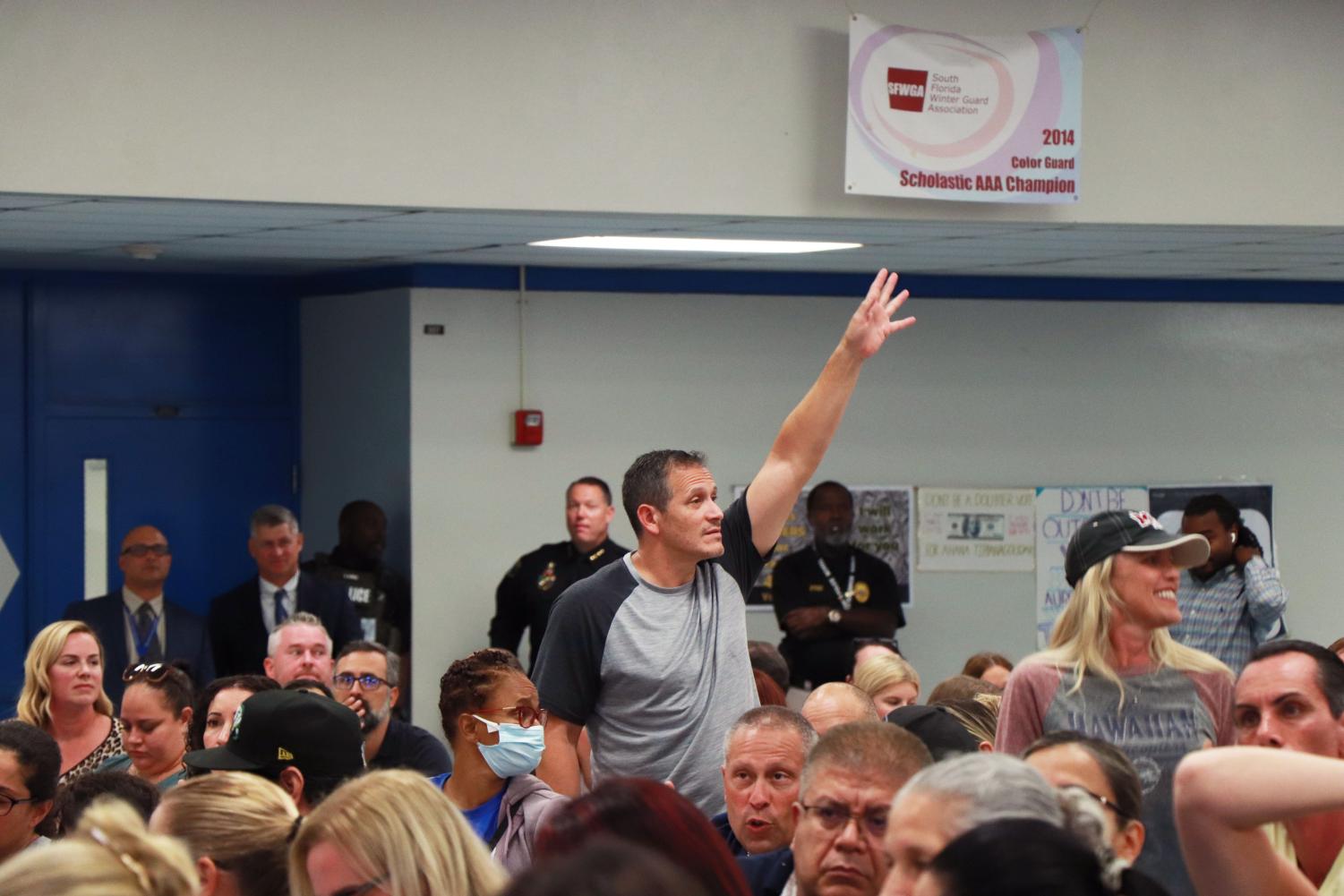
Keep ‘em Coming. A community member urgently raises his hand to ask a question at the Oct. 3 boundary meeting. After the demographer Joseph Beck went through the PowerPoint, the floor was opened up for questions about the process.
Making Proposals
Within BCPS, all proposals for boundary changes are made by the community and then evaluated by the BCPS Demographics and Enrollment Department and the School Board of Broward County. While the goal of this is to ensure community members have ample say in the process, it has caused division within the community.
The school administration was not involved in drafting any proposals. However, Principal Michelle Kefford did make one request of the district when they consider proposals next semester.
“I have asked that once kids establish themselves here not to pull them out, so that if and when the boundaries are changed, the kids who are currently here are to be phased [out] and allowed to finish their years at MSD,” Kefford said at MSD’s Sept. 14 School Advisory Committee meeting. “But it is up to the district, I just want what’s in the best interest for the kids.”
Actual proposal making can be tricky. Each one has take into account a list of factors that could make the proposal unusable or more favorable to the school board. Proposals also impacts the school’s enrollment numbers. In order to submit a proposal, a community member had to make an appointment with BCPS demographer Joseph Beck. Meetings were held via Microsoft Teams.
The idea that MSD is “Parkland school” is a common community misconception. While MSD’s address is within Parkland city limits, the reality is that 39% of students are Coral Springs residents.
School boundaries follow county lines and population numbers and are not decided by city limits; MSD is both a Parkland and Coral Springs school. Since it opened in 1990, MSD has always included students from both cities in its boundary.
However, even after this clarification, the partisan split in the community was evident at both community meetings.
Many Parkland parents were asking why their neighborhoods are included in some of the proposals and why the district is not automatically removing Coral Springs neighborhoods to reduce school population.
Coral Springs residents at both meetings brought up removing East Parkland neighborhoods since they are outside of the 2-mile walking radius for students.
Since proposals are created by the community, the neighborhoods that are being suggested for removal in the various proposals have created more “sides” in the process. Some maps cut out only Parkland neighborhoods and others cut out only Coral Springs neighborhoods. Some plans do remove both, growing the divide.
All proposals were due to the demographic department on Oct. 31 in order to give time for review before the second meeting with the community on Nov. 3. Demographics officials at this meeting discussed each individual proposal that was submitted, including factors that would be considered for each.
A total of 16 community proposals were submitted; however, two were withdrawn before the meeting, leaving 14 active proposals.
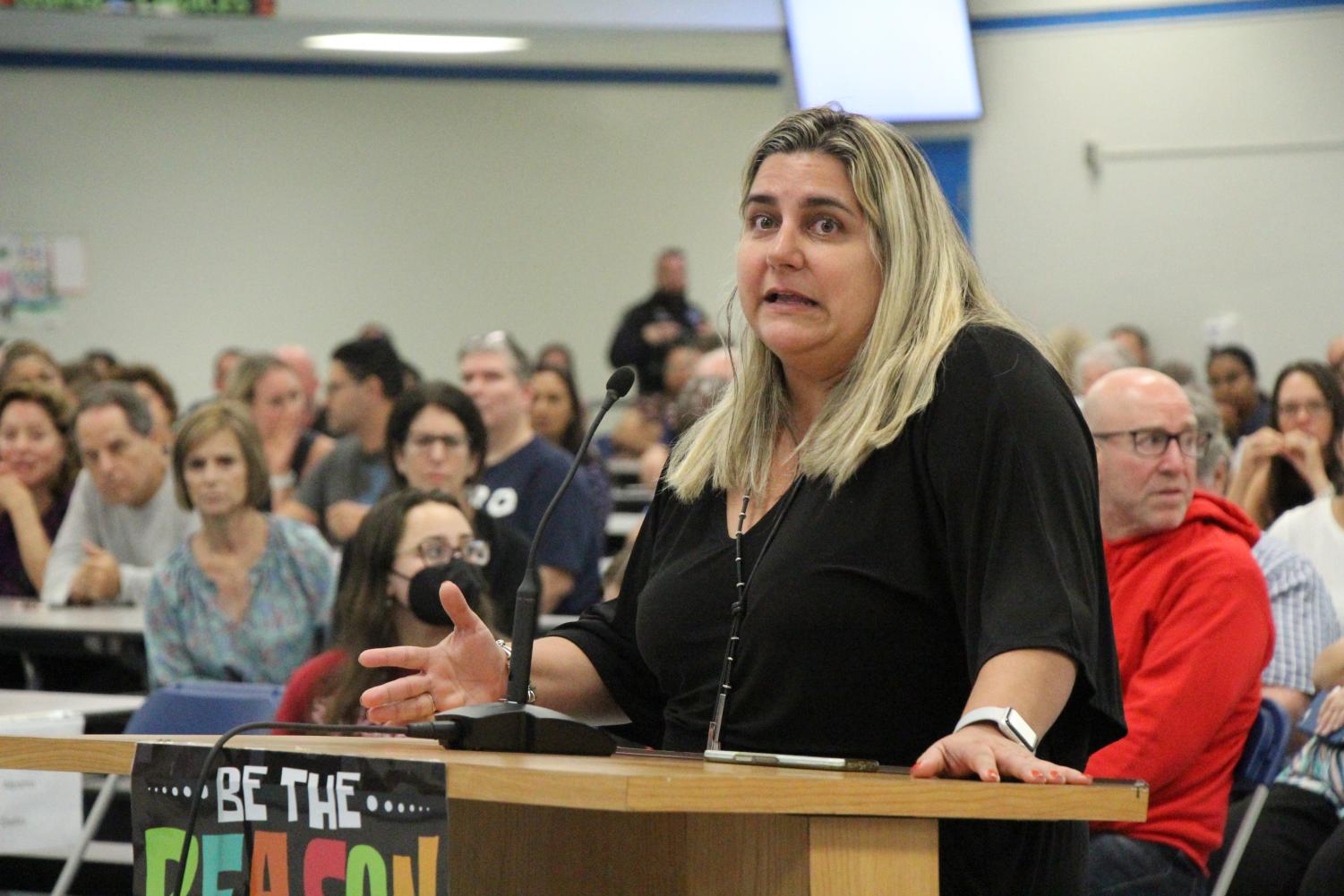
Speaking Sides. Elainey Carvallio expresses her concerns at the Nov. 3 boundary meeting about removing MSD students from the school boundary before the district completes a process to remove students attending MSD through falsified addresses.
Boundary Considerations
When weighing proposals, the BCPS Demographics and Enrollment Planning Department looks at several factors: class size impact, school concurrency level of service impact, enrollment, diversity, feeder patterns, school proximity impact, which includes transportation and 2-mile walk boundary, neighborhood integrity and natural barrier impacts. However, not all are relevant to MSD’s specific situation.
At the Nov. 3 meetings, parents made impassioned speeches in support of or against specific proposals. Community members could also leave public comments on the proposals online at the district’s website until Nov. 14.
“…There is only one map that meets all eight considerations. That map is C-1; it meets the class size impact, it meets the school concurrency level of service impact, it meets the enrollment impact, it also meets the diversity impact,” Parkland community member Kevin Hagens said at the Nov. 3 meeting. “Not only does it meet the diversity impact, it has the least aggregate impact on diversity out of all of the maps. C-1 is the only map that does not affect feeder patterns… every student moved under C-1 would be closer to Coral Glades than they would to MSD… so in light of the considerations that the school board has put forth, I think this is the map clearly that meets all of those when we are looking at this decision I think we keep those in mind.”
While class size impact is normally very important for boundary changes, MSD is currently meeting all class size requirements, according to Beck. All core classes are capped at 25 students.
Important factors in MSD’s boundary proposals include that the proposals cannot drastically alter the demographics of the school. BCPS defines drastically as a 5% difference; if a map were to cross this threshold, the school board would need to be notified. This is a newer rule, as previously, diversity was not counted and resulted in “wacky” and “insidious” proposals, according to Beck.
According to Demographics and Enrollment Planning Department, none of the proposals reduce diversity by over 5%.
“MSD has 439 Black students. By removing TAZ 107, 112 and 653 [in southern Coral Springs], the school is losing 98 Black students, 22% of the entire Black student population. [This is] not okay, not representative of Broward County’s diversity nor the schools in northwest Broward,” Coral Springs resident Jennifer Levi said at the Nov. 3 meeting. “…I know that the diversity impact comes into play…at 5%. However, with a school so minimally diverse as MSD, they can’t afford to lose any more diversity.”
Feeder patterns are the percentage of students that stay together from elementary school to middle school to high school. The idea is to allow students to stay together with their peers throughout elementary school to middle school to high school. For example, the feeder pattern for TAZ 49, located in East Parkland, follows the feeder pattern of Riverglades Elementary School to Westglades Middle School to MSD. The school board must be notified of a change to the feeder pattern.
Several proposals break the feeder patterns, including C-2, C-3, C-4, C-7, C-8, C-13 and C-15.
School proximity impact is another consideration weighed when adopting a new boundary; it examines if students in the affected areas will now have to travel farther to go to school.
One important consideration is whether a proposal removes students from within a 2-mile walking distance and places them at a school farther away, where walking is no longer an option. All BCPS schools have an identified 2-mile walking radius; students outside that are eligible to receive bus transportation to their school. Sending students to a school further away increases transportation costs for BCPS.
Proposals C-8 and C-15 would both remove students from TAZ 56, which is the neighborhood of Wyndham Lakes. Parts of TAZ 56 are included in the 2-mile walk radius of MSD. If moved, students living there would need to be bussed to their new school, Coral Glades High School.
C-2 removes all TAZs below Coral Hills Drive, which includes TAZs 107, 653 and 112. Students that live north of Sample Road, in TAZ 107, are closer to MSD than the proposed rezoned school: Coral Glades High School.
BCPS attempts to avoid splitting neighborhoods in half. Several proposals have had to be altered due to this consideration, which is called neighborhood integrity. C-2 splits The Hills in Coral Springs, and the proposer of the map is aware of this. C-7 splits Pine Tree Estates in East Parkland, though the neighborhood is large and spans three TAZs. C-12 also splits a neighborhood.
The natural barrier impact takes into account where there is a potential hazard that would allow students to qualify for a bus. This is more relevant to elementary school students, but the Demographics and Enrollment Planning Department did note the Sawgrass Expressway.
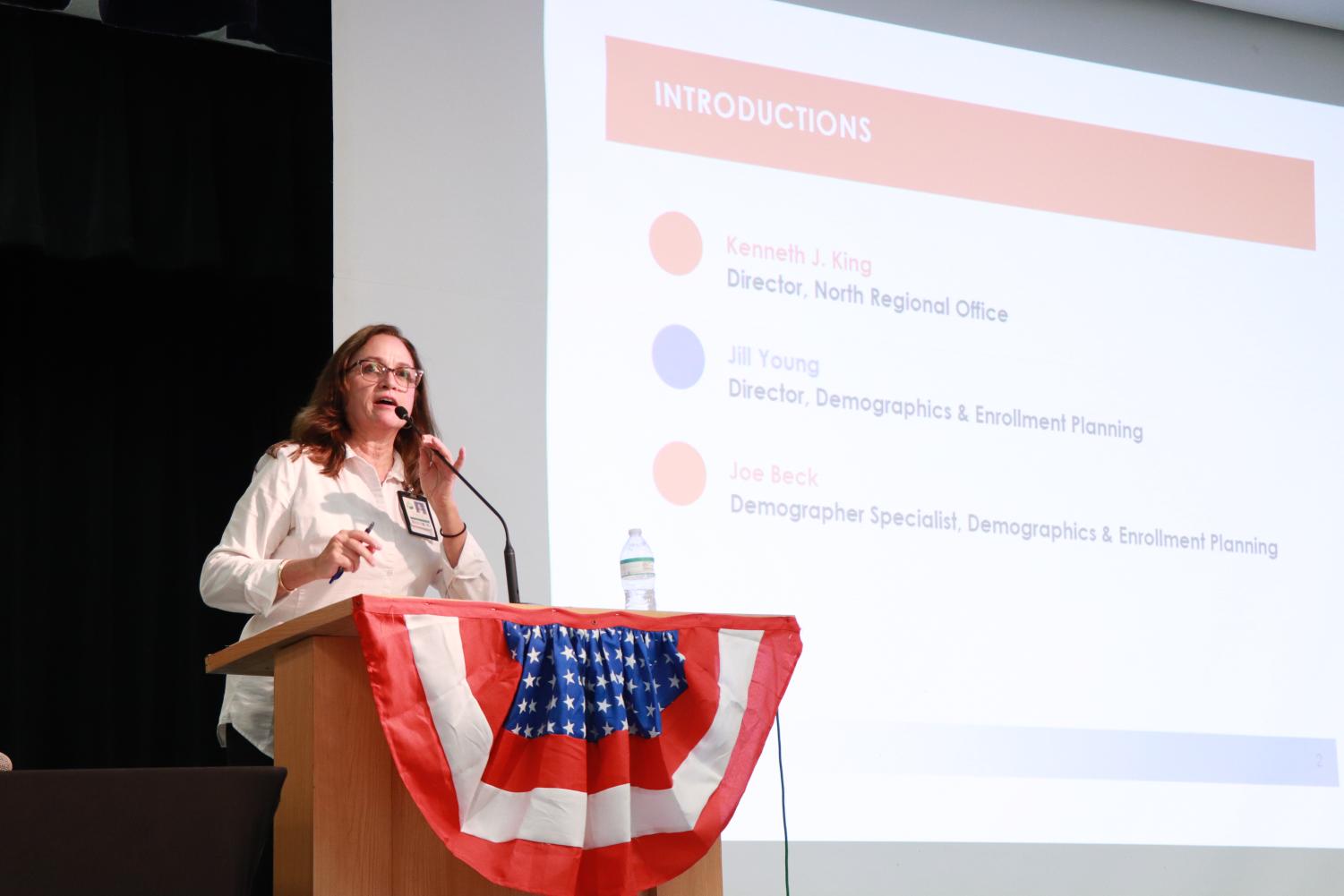
Selection day. Demographics & Enrollment Planning Department Director Jill Young introduces herself and explains her role in the process at the Oct. 3 meeting. The meeting provided information about the need to change MSD’s boundary lines, what the process will look like and how the community could participate in the process.
Breaking the Rules
In an additional effort to reduce overcrowding, MSD administration has attempted to remove all students that are currently living at an address outside of the MSD boundary. The guidance department required all students to re-register at the end of the last school year, in order to verify addresses before students could receive a schedule for this year.
Any student who moved outside the MSD boundary was unenrolled and required to go to their local school or apply for reassignment to another school. Some students were allowed to remain until the end of the last school year and had to attend their zoned school for this year.
The only exception to this rule are students with parents or guardians that actively serve in the military or students whose parents work for BCPS; they are allowed to apply for reassignment at schools within the general geographical area of their work location.
The crackdown on those living outside the boundaries continued throughout the summer; all submitted registrations were heavily reviewed by the MSD guidance department to ensure that the registration reflected accurate information about the student’s address. Any person that attempted to register under an address that does not fall into the MSD boundary or a false address that the student does not reside in was turned away.
However, MSD was not successful in identifying all cases; some MSD students that do not reside within the boundaries remain at MSD. According to Young, students and parents can report any students that live outside the boundaries to MSD administration.
Many students feel hesitant to report these students.
“I would not have reported them because it is not my business whether or not they are zoned for the school,” junior Carly Rogalla said. “You never know what is happening at home or why someone is attending Douglas rather than another school they are zoned for.”
While many parents at the Nov. 3 boundary meeting made it clear that they wanted all these students identified and removed, it is more complicated for some students.
“I understand the people who want to make the boundaries smaller, but I think they also have to consider others’ thoughts; most parents and students want to go to the best public school in the area, and MSD is,” sophomore John* said.
John* is one of many MSD students that do not live within the MSD boundaries. John* understands the complications of the removal of students that do not live within the boundaries; he does not want to see the removal of more students who have built their academic and social life at MSD, but he also believes that it was likely a wise decision to attempt to remove students before slimming the boundaries.
“It was important academically and socially because the school has great class options with all sorts of Advanced Placement options,” John* said. “But also, with COVID, it made me more shy and it was a bit harder for me to make friends. The people I did know were coming to this school, and we didn’t want me to start over [with] a new social group.”
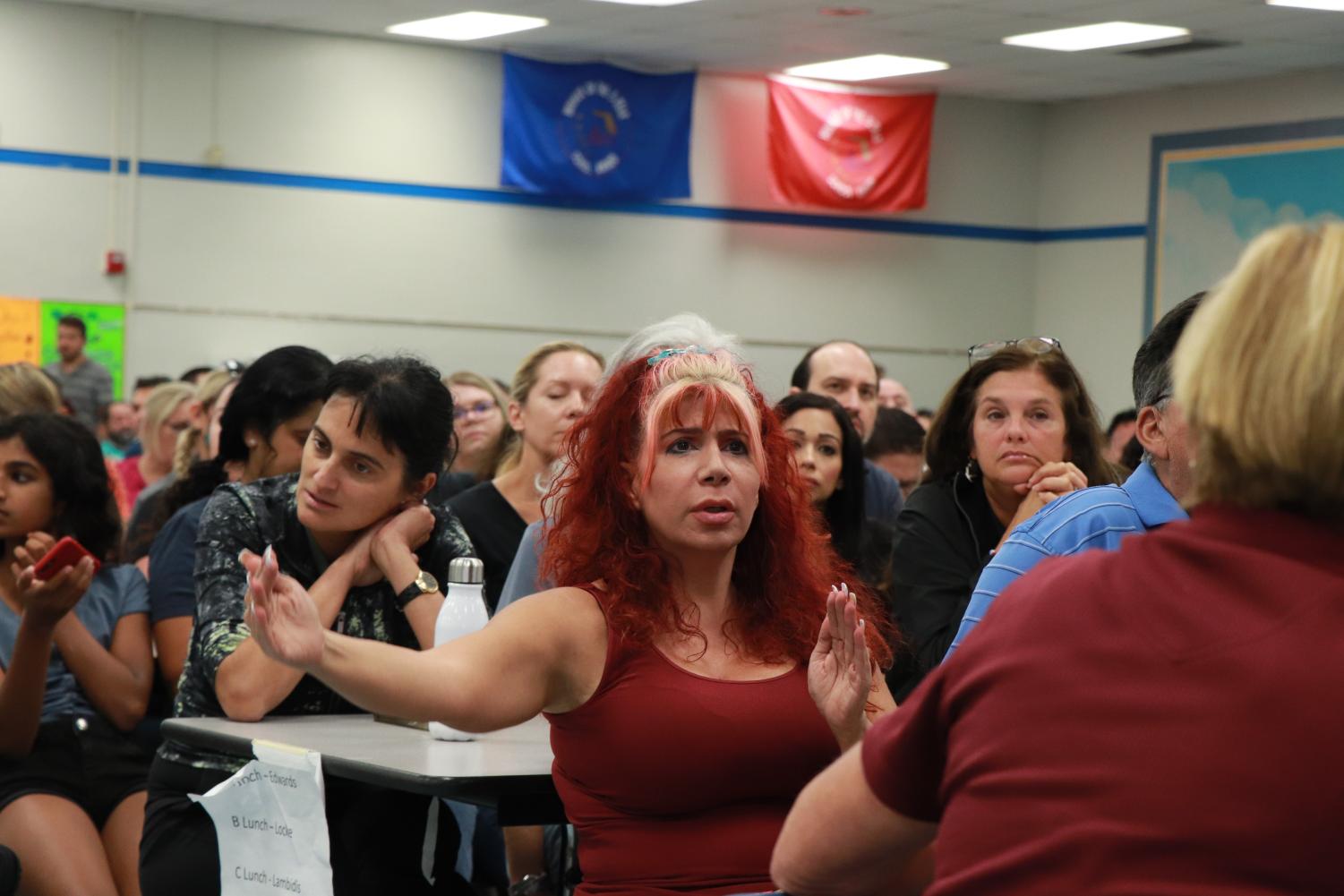
Scoping the School. Community member questions the scope at which the boundary process will take place. In January, the School Board, along with the superintendent, will review all proposals. They then have the option to give a recommendation which is then set to go into effect for the next school year.
What Now?
On Jan. 24, 2023, the nine school board members will receive an update on the boundary process and information on the submitted proposals. The board will weigh all the specified considerations about diversity, neighborhood integrity, transportation costs, etc.
The timeline also includes having the superintendent recommend one of the proposals to the board; however, the board has the final say. Dr. Vickie Cartwright is the current BCPS superintendent but was fired in November. Cartwright will hold her position until January. It is unknown if she will ultimately make a recommendation. It is also possible Cartwright could be reinstated as superintendent.
Public hearings will be held in February, March and April. The school board will make a final decision in April.
While the board could pick one proposal to be implemented, they could also decide not to act at all, if they deem none of the proposals adequate enough to be implemented. This would result in no change to MSD’s boundaries.
Frequently Asked Questions
Wasn’t the new 1500 building supposed to alleviate overcrowding at MSD?
The 1500 building, which opened in 2020, was intended to replace the now-unusable seats in the 1200 building. The 1200 building was deemed a crime scene following the shooting at MSD in 2018; school member Lori Alhadeff hopes to see the building knocked down in the summer of 2023. The 1500 building was not intended to alleviate the overcrowding that occurred even before the 1200 building became unaccessible. The 1500 building added 30 classrooms, and by extension, 750 students. This made up for the 1200 building that allowed for 713 students.
Is my current MSD student at risk of being zoned out when/if the boundary changes?
No. All 14 active, proposed plans include a phase-in. The phase-in method would allow all current MSD students to remain at the school for the rest of high school. The effects would only be felt by incoming students, as soon as next school year. This is particularly of note for students in the Exceptional Student Education at MSD; they will not be removed from their established routines.
My student has classes with over 25 students in them, how is MSD currently following class size guidelines if this is the case?
The 2002 Florida Class Size Reduction Amendment requires high school core classes to have a maximum of 25 students. MSD is adhering to those requirements, according to BCPS demographer Joseph Beck. However, the requirements apply only to core classes. Advanced placement classes and electives do not have such restrictions. For example, an Algebra II Honors class can have a maximum of 25 students, but an AP Statistics class has no class size limit. This means some classes can have 40 students, depending on demand and the number of periods offered.
Why can’t we move students in East Parkland to Monarch High School?
Monarch High School is currently overcrowded by 236 students. Due to this, no BCPS student can apply for reassignment to MHS except for students whose legal guardians are employees of BCPS. Several community submissions, including C-3, C-7, C-11, C-13 and C-14, proposed rezoning some areas of East Parkland to Coral Springs High School, which is under capacity by 609 students.
This is not the case for Coral Glades High School, which is over capacity by 168 students. Because 804 of their 2,781 students live outside the boundary and are reassigned to the school, if current areas of MSD boundaries were rezoned to Coral Glades High School, BCPS would simply reduce the number of reassignments at CGHS to accommodate for the phased-in arrival of students that would have gone to MSD.
Why can’t we build a new school?
District-wide, Broward County Public Schools is under-enrolled by 45,222 students, excluding charter schools, according to BCPS Enrollment Day data for 2022. BCPS cannot build another school while there are empty “seats,” according to Florida state law. At the Nov. 3 meeting, BCPS officials stressed that it is also unnecessary. While MSD is overcrowded, the extra students are not enough to fill a new school.
*Names indicated were changed to protect the students’ anonymity
This story was originally published in the December 2022 Eagle Eye print edition.
